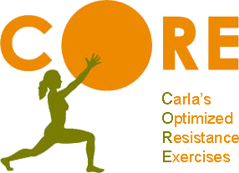Abdominal Plank Variations for a Stable and Strong CORE!
"I do 100 sit-ups a day!" a new client bragged.
"Great! How long can you hold a plank for?" I answer.
"A what?" he asks.
I get down on the ground and demonstrate a front plank. My new client quickly gets into a front plank position too, but sooner rather than later, falls to the ground, complaining that his back hurts. No core strength. Doing 100 sit ups a day may strengthen your outermost, superficial Rectus Abdominus muscles, but the deep, CORE muscles, responsible for protecting and stabilizing the back and hips, called the Transverse Abdominus muscles, get their stability and strength from planks! Planks protect your back, improve posture, and give you that nice, flat tummy look too! Go ahead, throw some sit-ups into your workouts every once in a while, but concentrate on planks, and you’ll feel taller and stronger from the inside out!
I'm going to teach you all kinds of plank progressions and variations, from beginner planks to advanced planks.
Let’s begin with a front plank, ideal for beginners and seniors just starting out….
Beginner Front Plank
Get into a Yoga Sphinx position — lie on your belly, legs outstretched behind you, resting on your elbows and forearms. Tuck your feet inwards and inhale. On the exhale, lift your torso off the mat, while drawing your belly up into your spine, contracting your core abdominal muscles. Your legs are still in contact with the mat. If you look under your torso at your feet as you lift off the floor/mat, you’ll feel an even greater abdominal contraction, but avoid sticking your butt into the air. Hold this plank for 30-60 seconds. Too easy? Try this more advanced front plank……
“Low” and “High” Front Planks
Begin in Sphinx pose like you did above, but this time, when you exhale, lift your entire body off the mat, including your legs, so that you are hovering on only your elbows/forearms and feet. Hold this isometric “low” front plank position for 30-60 seconds. If you feel your deep abdominal muscles trembling, you are doing it right! (Click the photos for enlargements).
“Low” Forearm Plank
You can also do a front plank in push-up position, arms long, with your wrists below your shoulder joints. Let’s call this plank a “high” plank. Remember, in both the “low” and “high” plank positions, keep your core tight, tummy pulled in, neck long, hips stable, shoulders neutral, and breathe!
“High” Plank
Once you have mastered a front plank, try some of these other fun and challenging plank variations…
1. Stationary Swiss-ball plank
Plank on a Swiss-ball secured against a wall, or in a Halo. (Click the photos for enlargements).
2. Unstable Swiss-ball plank
Plank on an unsecured Swiss-ball. You will need to really stabilize and tighten your core muscles, to keep the ball from escaping.
3. Swiss-ball movement planks
From your Swiss ball front plank position, inhale and roll the ball forward 2-6 inches. Your rib cage will lengthen as you move the ball, forcing you to further engage or lock-in your core abdominals. Exhale and roll ball back in. Now draw circles with the ball, as if you are stirring a large pot. Keep your CORE and hips stable, neck long, and chest and shoulders from sinking toward the ball.
4. Single Leg Plank
While in a front plank, lift a leg/foot off the ground and hold for 5-10 seconds. Don’t let your hips fall, and keep butt muscles tight. Change legs. Below is the Single-legged “High” Plank.
5. Single-Leg Plank Plus
Progress planks #3 and #4 by lifting a leg/foot off the ground. Be sure to keep hips square and butt muscles tight. You can challenge yourself even further with these single leg planks, by abducting/adducting the raised leg, or drawing circles with it, before bringing it back down. These planks are awesome butt workouts too, ouch!
6. Up and Down Plank
Start in a “high” front plank position. Keeping your core tight, and without rocking your hips, drop down into a “low” plank. Push back up into the “high” plank. Repeat 4-10 times more.
7. Two-point plank
Start in a front plank. Lift your right leg back, and your left arm forward at the same time. Remember, keep hips from sagging, tighten your tush, and lock in your core. Below is the Two-point “High” Plank.
8. Plank with donkey kicks
While in front plank position — either on your hands in “high” plank position, or on your forearms in “low” plank position – lift your right leg off the floor so that your foot is in line with your hips. Pull your knee in to touch your right elbow. Now kick it back again, like you are doing a butt blaster, contracting your butt muscles. Try 2-6 reps and change legs. To progress this exercise further, reach your knee to the opposite side elbow. This plank is best performed in the long-arm, “high” push-up position, so you will have enough room to tuck your knee beneath you.
There are many varieties of planks, even side planks of which, I haven’t even touched upon, but these should keep you busy for a while. Throw 2-4 plank variations into every one of your workouts, and you’ll develop strong abdominals, hips and glutes, better posture, spinal integrity, and a nice, flat tummy look.



